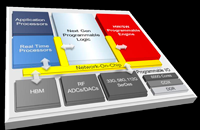Electronics News
Archive : 20 March 2018 год
 Future Facilities has launched Release 12 of its thermal simulation software, 6SigmaET. The latest release incorporates a number of significant modelling enhancements that the company says will help to boost overall simulation speed.
Future Facilities has launched Release 12 of its thermal simulation software, 6SigmaET. The latest release incorporates a number of significant modelling enhancements that the company says will help to boost overall simulation speed.
Release 12 includes a prototype virtual reality (VR) visualisation mode. In what it claims is a world first feature, Future Facilities says that it offers an insight into the potential for VR to open up new possibilities for thermal design analysis and optimisation.
The main focus of the release, however, is improvements that enable faster and more accurate modelling. This has resulted in the addition of a series of new modelling objects, the ability to simulate heat radiation and solar radiation through transparent materials, and new leak detection functionality for liquid cooling systems.
Release 12 also features the ability to create DELPHI compact models and an expanded library with integrations to support updated fan models from Papst and interface materials from Parker Chomerics. These integrations are intended to make it easier for thermal engineers to centralise data from across their organisation and their suppliers and create more accurate models.
Release 12 also offers usability and performance upgrades that extend the speed benefits of 6SigmaET. This includes enhancements to the software’s multi-level unstructured staggered grid system with a new boundary cell reconstruction method for more accurate geometry capture and support for 3D mouse control to make model manipulation even faster.
By connecting 6SigmaET with the Oculus Rift VR headset, Release 12 will allow engineers to view and explore their models in virtual reality for the first time. In future, engineers will be able to use VR to closely analyse and fix design issues from ‘inside’ their models.
Commenting on the new release, Tom Gregory, Product Manager at Future Facilities said, “Ultimately thermal simulation users want faster, easier to use and more accurate tools – and we’re continually evolving 6SigmaET to keep our users ahead in a fast-paced market. As part of that, we think it is important to focus our development not only on immediate enhancements, but also look further ahead.
“So, while Release 12 features a number of improvements that respond directly to our customers’ specific needs, we’re also breaking new ground with our VR capabilities. Although VR is still an emerging technology for industrial applications, we think there is enormous potential for it to bring new value as a user interface. As such, we wanted to take the lead in the industry and start to explore that potential now.”
Author
Neil Tyler
Source: www.newelectronics.co.uk
 Xilinx has announced, what it describes as, a new breakthrough product category called Adaptive Compute Acceleration Platform (ACAP) that provides capabilities significantly beyond that of an FPGA.
Xilinx has announced, what it describes as, a new breakthrough product category called Adaptive Compute Acceleration Platform (ACAP) that provides capabilities significantly beyond that of an FPGA.
An ACAP is a highly integrated multi-core heterogeneous compute platform that can be changed at the hardware level to adapt to the needs of a wide range of applications and workloads and can be done dynamically during operation.
The ACAP is intended to accelerate a broad set of applications in the emerging era of big data and artificial intelligence, such as: video transcoding, database, data compression, search, AI inference, genomics, machine vision, computational storage and network acceleration. According to the company both software and hardware developers will be able to design ACAP-based products for end point, edge and cloud applications.
The first ACAP product family, codenamed “Everest” will be developed in TSMC 7nm process technology and will tape out later this year.
“This is a major technology disruption for the industry and our most significant engineering accomplishment since the invention of the FPGA,” said Victor Peng, president and CEO of Xilinx. “This revolutionary new architecture is part of a broader strategy that moves the company beyond FPGAs and supporting only hardware developers. The adoption of ACAP products in the data centre, as well as in our broad markets, will accelerate the pervasive use of adaptive computing, making the intelligent, connected, and adaptable world a reality sooner.”
At its core the ACAP has a new generation of FPGA fabric with distributed memory and hardware-programmable DSP blocks, a multicore SoC, and one or more software programmable, yet hardware adaptable, compute engines, all connected through a network on chip (NoC). It also has highly integrated programmable I/O functionality, ranging from integrated hardware programmable memory controllers, advanced SerDes technology and leading edge RF-ADC/DACs, to integrated High Bandwidth Memory (HBM) depending on the device variant.
Software developers will be able to target ACAP based systems using tools like C/C++, OpenCL and Python. An ACAP can also be programmable at the RTL level using FPGA tools.
ACAP has been under development for four years at an accumulated R&D investment of over $1billion.Software tools have been delivered to key customers and Everest, which is expected to achieve 20x performance improvement compared to today's latest 16nm Virtex VU9P FPGA will tape out in 2018 with customer shipments in 2019.
Author
Neil Tyler
Source: www.newelectronics.co.uk
 Electronics design consultancy ByteSnap Design and a consortium of partners have been awarded a two-year collaborative project VIGIL (Vehicle-to-Grid Intelligent Control) under a Vehicle-to-Grid (V2G) competition, funded by the Office for Low Emission Vehicles (OLEV) and the Department for Business Energy and Industrial Strategy (BEIS).
Electronics design consultancy ByteSnap Design and a consortium of partners have been awarded a two-year collaborative project VIGIL (Vehicle-to-Grid Intelligent Control) under a Vehicle-to-Grid (V2G) competition, funded by the Office for Low Emission Vehicles (OLEV) and the Department for Business Energy and Industrial Strategy (BEIS).
ByteSnap along with partners Aston University, Nortech Management and Grid Edge will be focussed on developing a new communication and control platform for Vehicle-to-Grid/Building (V2G/V2B) systems: an off-vehicle system that controls how, when and the rate at which electric vehicle batteries are charged/discharged with respect to local substation constraints and EV/building energy requirements.
ByteSnap will be developing a communications adaptor, leveraging its expertise in EV charge post design. The adaptor will ensure flexibility and enable the VIGIL platform to operate with different manufacturer’s V2G charge-points. The consultancy will also be creating a V2G mobile application which will be delivered together with an optimised building management system.
Earlier this year OLEV and BEIS announced that 21 projects (8 feasibility studies, 5 collaborative research and development projects, and 8 real-world v2g trial projects) were to receive funding of £30m to develop the business proposition and core technology around V2Gm and demonstrate those with large-scale trials.
The projects involve over 50 industrial partners and research organisations from both the Energy and Automotive sectors, in what will be the largest and most diverse activities on V2G in the world, and involve trialling more than 2700 vehicles across the UK.
The V2G projects represent a significant step towards the transition to a low-carbon transportation and a smart energy system. Enabling EVs to return energy to the Power Grid when parked and plugged for charging, will increase Grid resilience, allow for better exploitation of renewable sources and lower the cost of ownership for EV owners - leading to new business opportunities and clear advantages for EV users and energy consumers.
Author
Neil Tyler
Source: www.newelectronics.co.uk

